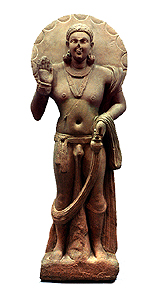
Kushan period, 2nd c CE
Sandstone
From Mathura, Uttar Pradesh, India
76 x 26 x 14 cm
Delhi Museum
Acquisition number: #59.530/1
Photograph: Daniel Waugh (copyright reserved)
It was during under the Kushans that the earliest known representational images of the Buddha were created. The creation of Buddhist sculpture was focused in two regions of the Kushan Empire, Gandhara and Mathura, each producing a distinctive sculptural style.
The image reproduced here was created in Mathura region, and like other Mathura Buddhist imagery, it demonstrates none of the Greco-Roman influence so obvious in Kushan-era imagery from the Gandharan region. Some art historians point to Mathuran imagery as evidence that a native Indian sculptural tradition was allowed to continue uninterrupted despite the rule of the foreign Kushans. This point of view is supported by the many stylistic similarities seen between Mathura sculpture and that created during the Maurya and Shunga (185-72 BCE) periods.
In particular, the emphasis on an organic, fleshy human form is often noted in Mathura imagery, as well as the near total nudity of the subjects. The hemlines of garments were often indicated simply by incising lines on otherwise bare arms, legs and torsos. The blank eyes common to Mathura sculpture is explained by the fact that these images would originally have been covered with pigment; not only would the white and pupils have been painted in, but the mandorla (halo), garments, and jewelry would have been richly colored (this is known due to the fact that, in some cases, pigment still remains in the deep recesses carved into the imagery).
Mathura sculpture is created from Fatehpur Sikri sandstone, a distinctive stone with a red hue, spotted and streaked with cream-colored imperfections for which it is highly valued (this is in spite of the fact that the stone's natural color would be ultimately be covered by pigment). Images made from this Fatehpur Sikri stone were carved and exported throughout north-central India during the Kushan era and well after.